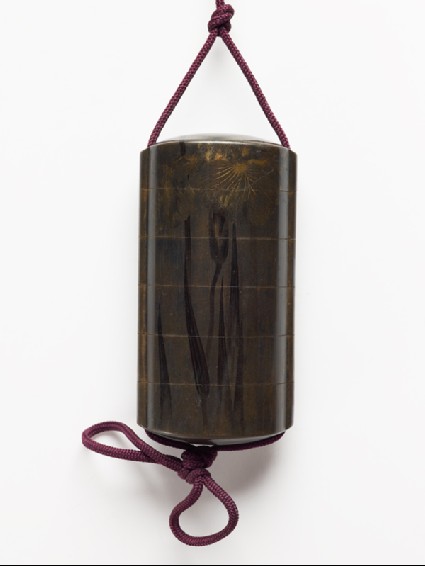Oriental Lacquer: Chinese and Japanese Lacquer from the Ashmolean Collections
A catalogue of the Ashmolean’s collection of Chinese and Japanese lacquer (published Oxford, 1983).

Publications online: 39 objects
- Reference URL
Actions
Inrō with irises
-
Literature notes
Inro, six cases. Irises, polished lacquer imitating sumi-e ink painting. Signed Kansai. -
Details
- Associated place
- Date
- 19th century (1801 - 1900)
- Artist/maker
-
Kansai (active 19th century) (lacquerer)
- Material and technique
- wood, covered in dark-silver lacquer, and with silver, gold, and black togidashi maki-e lacquer decoration; cord, probably silk and a replacement
- Dimensions
- without cord 10 x 5.1 x 3 cm max. (height x width x depth)
- Material index
-
organic › animal › animal product › silk,
- Technique index
- Object type index
- No. of items
- 6
- Credit line
- Presented by Sir Herbert Ingram, 1956.
- Accession no.
- EA1956.1750
-
Further reading
Impey, O. R., and M. Tregear, Oriental Lacquer: Chinese and Japanese Lacquer from the Ashmolean Museum Collections (Oxford: Ashmolean Museum, 1983), no. 12 b on p. xi, illus. p. 12
Glossary (4)
lacquer, maki-e, togidashi, togidashi maki-e
-
lacquer
Chinese and Japanese lacquer is made from the sap of the lacquer tree, which is indigenous to Eastern China. It is applied to wood as a varnish or for decorative effect. In India and the Middle East, lacquer is made from the deposit of the lac insect.
-
maki-e
(‘sprinkled design’) generic term for lacquer decoration using powdered metals sprinkled onto wet lacquer to create a design
-
togidashi
Technique in which the design in metal powders sprinkled over damp lacquer, is permitted to harden, then entirely covered with lacquer and finally after hardening, polished with abrasives to re-expose the design.
-
togidashi maki-e
(‘sprinkled designs revealed by polishing’) a type of makie in which the sprinkled design is covered with lacquer that is then polished away so that the design reappears flush with the surface
Location
-
- currently in research collection
Objects are sometimes moved to a different location. Our object location data is usually updated on a monthly basis. Contact the Jameel Study Centre if you are planning to visit the museum to see a particular object on display, or would like to arrange an appointment to see an object in our reserve collections.
Publications online
-

Oriental Lacquer: Chinese and Japanese Lacquer from the Ashmolean Collections
Inro, six cases. Irises, polished lacquer imitating sumi-e ink painting. Signed Kansai.
Notice
Object information may not accurately reflect the actual contents of the original publication, since our online objects contain current information held in our collections database. Click on 'buy this publication' to purchase printed versions of our online publications, where available, or contact the Jameel Study Centre to arrange access to books on our collections that are now out of print.
© 2013 University of Oxford - Ashmolean Museum



